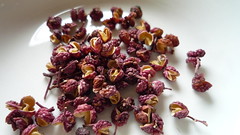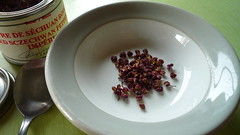One-Two Punch
 fig. a: one
fig. a: one
 fig. b: two
fig. b: two
This has got to be one of the world's great combination punches: Sichuan chiles + Sichuan pepper. The first blow packing considerable amounts of heat, the second providing an odd numbing effect that allows one to somehow consume all that firepower. It's certainly one of our favorites, and last week when the two of us found ourselves feeling a bit under the weather, we knew that that lethal Sichuan kick was just what we needed. We also knew we wanted something brothy, something like Water-Boiled Beef, so we turned to our good friend Fuchsia Dunlop to see what she had to say.
If you're still unfamiliar with Dunlop's 2001 instant-classic Land of Plenty: Authentic Sichuan Recipes Personally Gathered in the Chinese Province of Sichuan (as we were until just a few months ago), and you love the searing heat and sophistication of real Sichuanese cuisine, you're in for a treat. Land of Plenty is a remarkably comprehensive cookbook that's honest, and forthright, and full of heart. Its opening section begins with a passionate and insightful introduction (our favorite part: the section on "Diffferent Food Traditions" that discusses homestyle cooking, street food, and banquet cooking [!]), continues with detailed and fascinating overviews on "basic cutting skills," "cooking methods," "equipment," and stocking "the Sichuanese pantry," and, really, the book never lets up. Seriously, just when you think Dunlop can't possibly have anything more to add, she drops in appendices on "the 23 flavors of Sichuan" (e.g. #4: hot and numbing flavor) and "the 56 cooking methods of Sichuan" (e.g. #6: bao: "explode frying").
With Dunlop as our guide, we'd been traveling through Land of Plenty for a number of months, but we'd yet to make her Water-boiled Beef, which she actually gives another name. If you've never experienced the full power of this benign-sounding dish, Dunlop's introduction sets the scene:
Sichuanese people joke that outsiders, wary of the fiery local flavors, order this dish in restaurants in the hope of eating something mild and soothing... In fact, it's sensationally hot... It's not for the faint-hearted, but if you have a taste for spicy food, it's fabulous, and perfect for a cold winter's day when you need firing up with energy and warmth. As they say in Sichuan, it'll make you pour with sweat, even on the coldest days of the year.
As a result, though Dunlop notes that the dish's name (shui zhu niu rou) simply means "beef boiled in water," she calls her version Boiled Beef Slices in a Fiery Sauce.*
Sound like fun? It is. You see, as if that Sichuan chile-Sichuan pepper one-two punch weren't enough, Water-boiled Beef's combo actually contains one last furnace blast: what Dunlop calls "lashings" of chili bean paste, a pungent, powerful chile and fava bean concoction.
 fig. c: three
fig. c: threeDon't settle for imitations. Look for the real thing. This brand's the best we've found here in Montreal.
 fig. d: Imperial Sichuan pepper
fig. d: Imperial Sichuan pepperAlso, if you haven't tried Philippe de Vienne's "Imperial" Sichuan pepper, we highly recommend that too. No other Sichuan pepper we've encountered is as potent or as floral.
And just how does one go about making Water-boiled beef? We're glad you asked.
Water-boiled Beef
1 head of celery (about 1 lb), fibrous outer edges removed, chopped into 2" x 1/2" sticks
4 scallions, gently crushed and chopped into matching 2" x 1/2" sticks
a small handful of Sichuan chiles (roughly 8-10), snipped in half, seeds removed
1 lb lean beef (flank steak, for instance), sliced against the grain into 1" x 2" strips
salt
1 tbsp Shaoxing rice wine or medium-dry sherry
1/3 cup peanut oil
2 tsp Sichuan pepper
3 tbsp chili bean paste
3 cups chicken stock, preferably homemade
2 tsp dark soy sauce
6 tbsp cornstarch mixed with 6 tbsp cold water
Add 1/4 teaspoon of salt and the Shaoxing rice wine to the beef strips, mix well, and allow to marinate while you prepare the other ingredients.
Heat 3 tablespoons of oil in a wok until hot but not yet smoking. Add the chiles and the Sichuan pepper and stir-fry until fragrant and the chiles are just beginning to brown (taking care not to burn them, however). Immediately slide the spices into a bowl, leaving the oil in the wok. When they have cooled down a bit, transfer the spices to a cutting board and, using a cleaver, chop them finely, then set them aside.
Return the oily wok to the stove and heat over a high flame. When it begins to smoke, add the vegetables and stir-fry for a minute or two, adding 1/4-1/2 teaspoon salt to taste, until they are hot and just-cooked but still crunchy. Transfer the vegetables to the serving bowl.
Heat another 3 tablespoons of oil in the wok over a high flame, until just beginning to smoke. Turn the heat down to medium, add in the chili bean paste, and stir-fry for about 30 seconds, until the oil is red and fragrant. Add the stock and the dark soy sauce, season to taste with salt, and return to a boil over a high flame. Add the cornstarch mixture to the beef and stir well in one direction to coat all the pieces. When the sauce is boiling vigorously, carefully drop in the beef slices. Wait for the sauce to return to a boil and then use a pair of chopsticks to gently separate the slices. Simmer for a minute or so, until the beef is just cooked, and then spoon it onto the waiting vegetables. Pour the sauce over top.
Swiftly rinse out the wok and dry it well. Heat another 3-4 tablespoons of oil in the wok until smoking. Sprinkle the chopped chiles and the Sichuan pepper over the beef dish and then pour over the smoking oil, which should sizzle dramatically. If you move quickly, the dish should still be hissing and sizzling when you bring it to the table.
Serves two as a main dish, four with rice and two or three side dishes.
Did it work? You bet. That Water-boiled Beef was a knockout.
aj
* See? What did I tell you? Honest and forthright.










1 comment:
Hi Anonymous,
I would halve the chilies if you're concerned. Omitting them altogether would defeat the purpose. Remember, the sichuan pepper is your friend. It helps you tolerate extra heat.
Enjoy.
Post a Comment